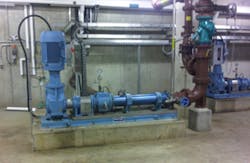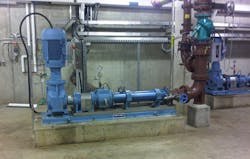Wastewater Treatment Plant Overcomes Pump Failures with New Elastomer Compound
The wastewater treatment requirements in the Canadian city of Hamilton are extensive to say the least, as the city must support not only its own needs, but also those of many surrounding districts and towns. The city’s wastewater treatment facilities are under considerable pressure to handle large volumes of combined wastewater and sanitary sewage—a situation that is illustrated perfectly at the city’s Woodward Avenue Wastewater Treatment Plant.
Built in 1964, the Woodward Avenue facility currently processes around 108 million gallons (409 million liters) of sewage each day, and when demand rises, this figure can hit a peak of over 158 million gallons (600 million liters) per day. Given the abrasive nature of the sludge and wastewater involved, this demanding challenge has traditionally taken its toll on the plant in the shape of high levels of damage to its progressing cavity pumps, and specifically to the nitrile elastomer stators inside the pumps.
Progressing-cavity pumps are perfectly suited to this type of sewage handling duty, as they provide a smooth and continuous delivery of the pumped media. However, the stator elements can be subject to attack from the abrasive and corrosive sludge, and in the case of the Hamilton plant this was reducing their working life quite considerably. With the need to maintain and replace these stators creating significant time and cost penalties, the plant authorities were prompted to look for a more appropriate elastomer solution.
The pressure to find a more effective elastomer was intensified by the role that the treatment plant plays in maintaining the environmental quality of the surrounding area, especially that of the ecosystem in the nearby Hamilton Harbor. Human activity in the region has adversely affected the ecosystem in the region, particularly in Windermere Basin, which is situated on the mouth of Red Hill Creek at the eastern end of Hamilton Harbor. Effective and reliable treatment of the sewage and wastewater from the plant is essential if this ecosystem is to be protected in the future.
READ ALSO: CASE STUDY – California Winery Achieves ‘Green’ Wastewater Process with Submersible Pump Setup
The plant authorities eventually chose to partner with Moyno to tackle the situation. With over 75 years experience of developing progressing-cavity pump technology, Moyno was well placed to help. Together, the two organizations began to work on creating a new stator, which would withstand the impact of the viscous, abrasive, solids-laden slurries and sludges found in this large-scale municipal application. The work began by analyzing the different characteristics of the sludge, along with its flow patterns and the varying operational demands that fell on the treatment plant. This helped Moyno identify the specific performance parameters required from the new stator, and then select the most appropriate type of elastomer material accordingly. The company had recently developed an elastomer, which was well-suited to these requirements, and subsequent testing confirmed that if new stators were made from this material, they could be relied on to deliver effective performance and a long and reliable working life. If this proved to be true in practice, it would mean that the Hamilton plant would be able to look forward to both lower maintenance times and reduced costs.
Testing and development work confirmed that the new urethane elastomer compound should be more than a match for the operating conditions at the Hamilton plant. It offered a tough and rugged alternative that had a far greater resilience than the original nitrile elastomer material, and so a replacement stator was manufactured and installed.
It would be fair to say that the results that followed were surprising, with the new urethane stator far-exceeding the performance it had been expected to provide. It proved to be both effective and reliable, and eventually outlasted the original nitrile stator by more than 10 times. This highlighted the enormous potential for this solution to reduce maintenance costs and time, and prompted the treatment plant authorities to place an immediate order for five additional stators made from the new urethane material.
Two versions of the urethane material are now available, both of which offer the same superior performance and outstanding resistance to wear in abrasive conditions. The RM720 black urethane elastomer version is intended for use in the challenging environments of a typical industrial or municipal application, while the white RM715 urethane elastomer uses FDA approved materials. This allows it to provide similarly impressive and abrasion-resistant performance, but also meet the hygiene requirements of food industry applications.
The benefits of the new stator material were not restricted to the Hamilton plant itself, however, as it also made a significant contribution to the overall performance of the area’s wastewater treatment system. In particular, it helped an ongoing environmental project designed to improve conditions in the Windermere basin, and which has since transformed a body of low-quality water with a limited range of ecodiversity into a healthy and diverse coastal wetland. The project involved creating a new wetland area and containment dykes, installing hydraulic controls, a power building, a fish way and local landscaping. This has delivered environmental benefits that now allow the improved Windermere basin area to support larger aquatic and bird species populations, and it has also provided extra leisure facilities for residents in what is an otherwise industrialized area of Hamilton. However, the impressive end results depend on the work of the wastewater treatment plants such as the Hamilton facility being successful if the improvements are going to be sustained.
Local representatives from many of the area’s governing authorities have confirmed their commitment to improving the quality of life in the area. “It’s good to know that we have been able to play our part in helping them achieve that,” says Adam Downey, new product development manager at Moyno. “We adopt a partnership approach to working with our customers so that we can develop solutions that meet their needs exactly. It’s good when we achieve that aim, but it feels even better to know that our specialist expertise has made a contribution to a much wider program that will benefit so many people.“
This blog post was provided by Moyno Inc., a supplier of progressing-cavity pump solutions. For more information, visit www.moyno.com.



